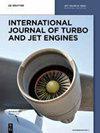Impact of cavity and ramp configuration on the combustion performance of a strut-based scramjet combustor
IF 0.9
4区 工程技术
Q4 ENGINEERING, AEROSPACE
引用次数: 0
Abstract
Abstract The flow performance of a dual wall-mounted cavity in a strut-injector scramjet combustor in steady reacting flow conditions is computationally analyzed. A baseline configuration corresponding to DLR experiments and two proposed configurations with varying bottom wall cavity depth and fixed top wall ramp is considered. Steady-flow computations are performed using the 2-D Reynolds Averaged Navier–Stokes method with k-ω SST turbulence closure coupled and single-step reaction chemistry. The calculated flow patterns, density, pressure, and temperature fields are compared with shadowgraph and wall pressure measurements from DLR experiments. The cavity and strut are mounted downstream of the strut to analyze the shock patterns and their interference with the shear layer mixing features. The estimated flow patterns, density, pressure, and temperature fields are compared with shadowgraph and wall pressure measurements from DLR experiments. Incorporating cavity and ramp configuration provides earlier complete combustion compared to the baseline model, with a marginal rise in the total pressure caused by additional shock wave formation that emanates from the corners of the cavity and ramp. The combustion zone widens in the lateral direction as the cavity shifts the shock train downstream of the strut injector owing to intense shock shear layer interactions.空腔和斜面结构对支杆式超燃冲压发动机燃烧室燃烧性能的影响
文摘:对支杆喷射器超燃冲压发动机燃烧室中双壁安装腔在稳定反应流条件下的流动性能进行了计算分析。考虑了与DLR实验相对应的基线配置和两种所提出的具有不同底壁空腔深度和固定顶壁斜面的配置。使用二维雷诺平均纳维-斯托克斯方法,结合k-ωSST湍流闭合耦合和单步反应化学,进行定常流计算。将计算出的流型、密度、压力和温度场与DLR实验中的阴影图和壁压测量值进行比较。空腔和支柱安装在支柱的下游,以分析冲击模式及其对剪切层混合特征的干扰。将估计的流型、密度、压力和温度场与DLR实验的阴影图和壁压力测量值进行比较。与基线模型相比,结合空腔和斜坡配置提供了更早的完全燃烧,总压力的边际上升是由从空腔和斜坡的角落发出的额外冲击波形成引起的。由于强烈的冲击剪切层相互作用,当空腔将冲击序列转移到支柱喷射器的下游时,燃烧区在横向方向上变宽。
本文章由计算机程序翻译,如有差异,请以英文原文为准。
求助全文
约1分钟内获得全文
求助全文
来源期刊

International Journal of Turbo & Jet-Engines
工程技术-工程:宇航
CiteScore
1.90
自引率
11.10%
发文量
36
审稿时长
6 months
期刊介绍:
The Main aim and scope of this Journal is to help improve each separate components R&D and superimpose separated results to get integrated systems by striving to reach the overall advanced design and benefits by integrating: (a) Physics, Aero, and Stealth Thermodynamics in simulations by flying unmanned or manned prototypes supported by integrated Computer Simulations based on: (b) Component R&D of: (i) Turbo and Jet-Engines, (ii) Airframe, (iii) Helmet-Aiming-Systems and Ammunition based on: (c) Anticipated New Programs Missions based on (d) IMPROVED RELIABILITY, DURABILITY, ECONOMICS, TACTICS, STRATEGIES and EDUCATION in both the civil and military domains of Turbo and Jet Engines.
The International Journal of Turbo & Jet Engines is devoted to cutting edge research in theory and design of propagation of jet aircraft. It serves as an international publication organ for new ideas, insights and results from industry and academic research on thermodynamics, combustion, behavior of related materials at high temperatures, turbine and engine design, thrust vectoring and flight control as well as energy and environmental issues.
 求助内容:
求助内容: 应助结果提醒方式:
应助结果提醒方式:


